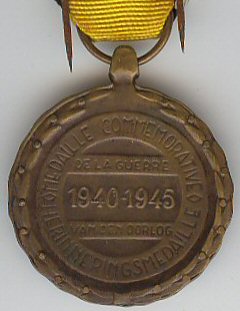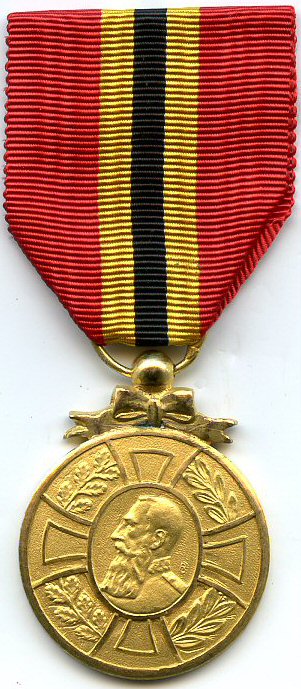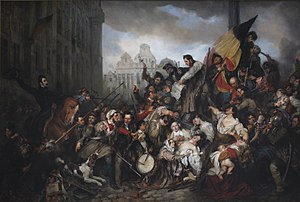
The Order of Leopold is one of the three current Belgian national honorary orders of knighthood. It is the oldest and highest order of Belgium and is named in honour of its founder, King Leopold I. It consists of a military, a maritime and a civil division. The maritime division is only awarded to personnel of the merchant navy, and the military division to military personnel. The decoration was established on 11 July 1832 and is awarded by Royal decree.
The Order of Leopold II is an order of Belgium and is named in honor of King Leopold II. The decoration was established on 24 August 1900 by Leopold II as Sovereign of the Congo Free State and was in 1908, upon Congo being handed over to Belgium, incorporated into the Belgian awards system. The order is awarded for meritorious service to the sovereign of Belgium, and as a token of his personal goodwill. It can be awarded to both Belgians and foreigners, and is seen as diplomatic gift of merit.
The Military Cross is a military long service decoration of Belgium. It was established by Royal Decree on 11 February 1885 and is awarded to commissioned officers in the Belgian Armed Forces for loyal and uninterrupted service or to Non-Belgian military officers for distinguished service in favor of the Military of Belgium.

The Volunteer Combatant's Medal 1914–1918 was a Belgian wartime service medal established by royal decree on 17 June 1930 and awarded to Belgian citizens and foreign nationals who voluntarily enlisted for service in the Belgian Armed Forces during World War I.
The Civic Decoration is a civilian decoration of the Kingdom of Belgium. It was first established by royal decree on 21 July 1867 to reward exceptional acts of bravery, devotion or humanity. A further royal decree of 15 January 1885 extended the award to state civil servants for long service by a mere change of ribbon. The award statute was once again amended by royal decree in 1902 to include long service in the Civic Guard and firefighters, each with its distinctive ribbon.

The Commemorative Medal for Armed Humanitarian Operations is a military decoration of Belgium. It was established on 11 September 1987 and is awarded to military and civilian members of the Belgian Armed Forces who participated in armed humanitarian operations. Although never explicitly stated, in practice, the medal is only awarded for a select number of operations on African soil.

The Commemorative Medal of the 1940–45 War was a military decoration of Belgium. It was established by royal decree of the Prince Regent on 16 February 1945 to recognise Belgian servicemen and women who served during World War II. It was also awarded to members of the Belgian Resistance and members of Belgium's Merchant Navy on the side of the Allies. Later decrees allowed for its award to foreign recipients of the Belgian Croix de Guerre.
The Croix de guerre (French) or Oorlogskruis (Dutch) is a military decoration of the Kingdom of Belgium established by royal decree on 25 October 1915. It was primarily awarded for bravery or other military virtue on the battlefield. The award was reestablished on 20 July 1940 by the Belgian government in exile for recognition of bravery and military virtue during World War II. The post-1940 decoration could also be awarded to units that were cited. The decoration was again reestablished by royal decree on 3 April 1954 for award during future conflicts.

The Yser Medal was a Belgian campaign medal of World War I, established on 18 October 1918 to denote distinguished service during the 1914 Battle of the Yser in which the Belgian Army stopped the German advance of the German invasion of Belgium.

The Commemorative Medal of the 1914–1918 War was a Belgian commemorative war medal established by royal decree on 21 July 1919 and awarded to all members of the Belgian Armed Forces who served during the First World War that were eligible for the inter-allied victory medal.

The 1940–1945 Military Combatant's Medal was a Belgian war medal established by royal decree on 19 December 1967 and awarded to all members of the Belgian Armed Forces who fought from the United Kingdom during the Second World War.

The Volunteer's Medal 1940–1945 was a Belgian war medal established by royal decree of the Regent on 16 February 1945 and awarded to Belgian and foreign civilians who voluntarily enlisted in the Belgian Armed Forces during the Second World War. The medal could also be awarded to volunteers serving in the Belgian units of the Royal Air Force, Royal Navy or British merchant navy.
The 1940–1945 Colonial War Effort Medal was a Belgian war service medal established by royal decree of the Regent on 30 January 1947 and awarded to government civil servants, magistrates, volunteer members of the female auxiliary service, missionaries, civilian agents of the different departments and civilians who served honourably for at least one year in the Belgian Congo or Ruanda-Urundi colonies of the Kingdom of Belgium in Africa between 10 May 1940 and 7 May 1945.

The Commemorative Medal of the Reign of King Leopold II was a Belgian civilian and later military and police forces medal originally established on 21 July 1905 by royal decree to commemorate the 40th year of the reign of King Leopold II.

The Commemorative Medal of the Reign of King Albert I was a Belgian military medal established on 17 February 1962 to commemorate the reign of Albert I of Belgium.

The Political Prisoner's Cross 1940–1945 was a Belgian war medal established by royal decree of the Regent on 13 November 1947 and awarded to Belgian citizens arrested and interned by the Germans as political prisoners during the Second World War. The award's statute included provisions for posthumous award should the intended recipient not survive detention, and the right of the widow, the mother or the father of the deceased to wear the cross.

The Centenary of National Independence Commemorative Medal 1830-1930 was a Belgian commemorative medal established by royal decree on 20 July 1930 to commemorate the 100th anniversary of Belgian independence.

The Iron Cross was established by law in 1833 following the end of the Belgian Revolution to recognise serious wounds received and bravery in battle by Belgian citizens taking part in the fight for Belgian independence from the United Kingdom of the Netherlands between 25 August 1830 and 4 February 1831. A further royal decree of 22 August 1834 created a second class to the Iron Cross for award to all wounded combatants. Due to the lower perceived importance of the second class award and discontent among recipients, the Iron Cross second class was short-lived and amalgamated to the Iron Cross first class by decree of 21 February 1835. All recipients now received the (original) first class award.

The Commemorative Decoration of the 50th Anniversary of the Creation of the Railroads 1834-1884 was a Belgian commemorative award denoting the 50th anniversary of the law of 1 May 1834 ordering the creation of railroads in Belgium. It was established by royal decree of King Leopold II on 30 April 1884 at the suggestion of the ministers of Public Works and of the Interior, its statute was ratified by a further royal decree on 11 July 1884.

The Queen Elisabeth Medal was a Belgian decoration created by royal decree in October 1916 to recognise exceptional services to Belgium in the relief of the suffering of its citizens during the First World War. Its statute was ratified on 14 May 1919. It was awarded to people, both Belgians and foreign nationals, who, like Queen Elisabeth herself, had worked and cared for the suffering victims of war for a year or more prior to 10 September 1919. Although not limited to medical care of the sick and wounded, recipients who earned the medal by working in hospitals received a variant with a red enamelled cross within the suspension wreath. A great many Belgian and foreign doctors and nurses received the medal.



















